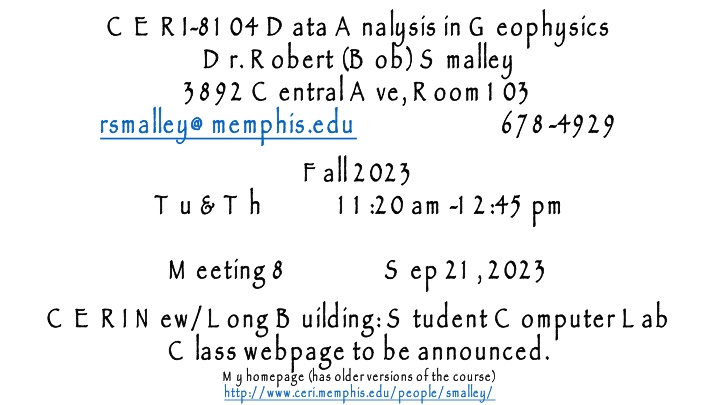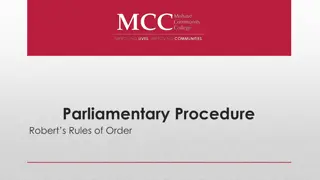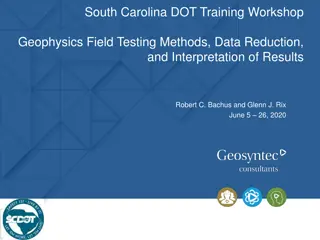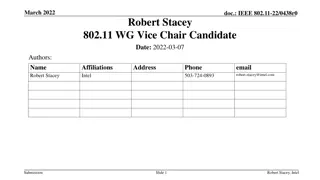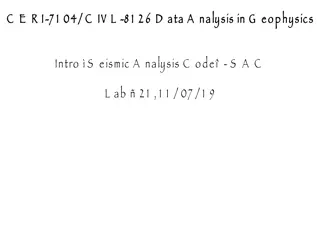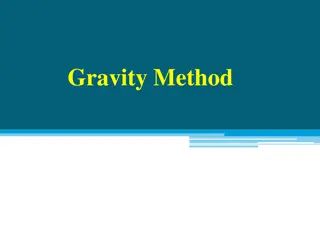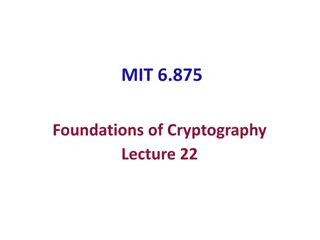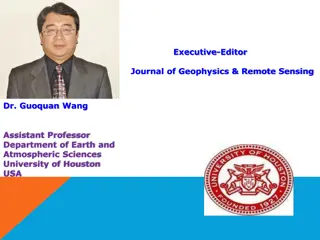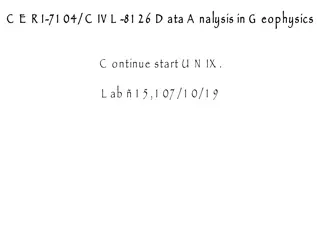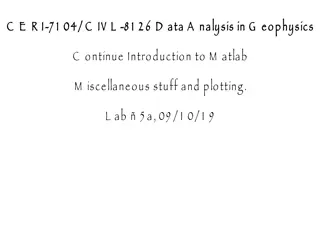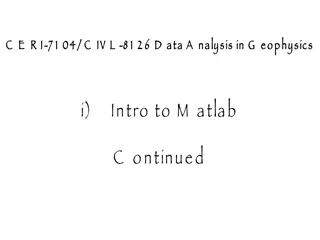Data Analysis in Geophysics with Dr. Robert (Bob) Smalley
Explore the world of geophysics data analysis with Dr. Robert Smalley in this informative course. Dive into topics like plotting in 3D, structuring data effectively, and utilizing interactive tools. Uncover the power of structures in organizing and manipulating data for geophysical insights. Enhance your skills in interpreting and visualizing geophysical data with practical examples and demonstrations. Join Dr. Smalley on a journey through data analysis techniques specific to the field of geophysics.
Uploaded on Mar 08, 2025 | 2 Views
Download Presentation

Please find below an Image/Link to download the presentation.
The content on the website is provided AS IS for your information and personal use only. It may not be sold, licensed, or shared on other websites without obtaining consent from the author.If you encounter any issues during the download, it is possible that the publisher has removed the file from their server.
You are allowed to download the files provided on this website for personal or commercial use, subject to the condition that they are used lawfully. All files are the property of their respective owners.
The content on the website is provided AS IS for your information and personal use only. It may not be sold, licensed, or shared on other websites without obtaining consent from the author.
E N D
Presentation Transcript
C E R I- -8 1 04 D ata A nalysis in G eophysics D r. R obert (B ob) S malley 3 8 9 2 C entral A ve, R oom 1 03 rsmalley@ memphis.edu F all 2 02 3 T u & T h 1 1 :2 0 am 8 1 04 D ata A nalysis in G eophysics D r. R obert (B ob) S malley 3 8 9 2 C entral A ve, R oom 1 03 rsmalley@ memphis.edu F all 2 02 3 T u & T h 1 1 :2 0 am - -1 2 :45 pm C E R I 6 7 8 6 7 8 - -49 2 9 49 2 9 1 2 :45 pm M eeting 8 M eeting 8 S ep 2 1 , S ep 2 1 , 2 02 3 2 02 3 C E R I N ew/ L ong B uilding: S tudent C omputer L ab C lass webpage to be announced. M y homepage (has older versions of the course) http:/ / www.ceri.memphis.edu/ people/ smalley/ C E R I N ew/ L ong B uilding: S tudent C omputer L ab C lass webpage to be announced. M y homepage (has older versions of the course) http:/ / www.ceri.memphis.edu/ people/ smalley/
C an plot 3 Interactive, can rotate, sample, etc. this figure also C an plot 3 - -d view with contour plot on Interactive, can rotate, sample, etc. this figure also d view with contour plot on xy xy plane. plane. sc=surfc(xy,'EdgeColor','none') colorbar
th=[0:300]/100*2*pi; x=sin(th); y=cos(th); xy=x'*y; imagesc(xy) colorbar xablel('x index') ylabel('y index') title('ex surfc ) imagescdoes not rotate. does not rotate.
P lot in 3 P lot in 3 - -d d t = 0:pi/50:10*pi; plot3(sin(t),cos(t),t); T his is also interactive T his is also interactive
B eyond simple array variables B eyond simple array variables S tructures S tructures S tructures are like a suitcase, they contain lots of separate distinct things that you can take out and put in individually, and you can also pass the whole suitcase with its contents around. S tructures are like a suitcase, they contain lots of separate distinct things that you can take out and put in individually, and you can also pass the whole suitcase with its contents around.
B eyond simple array variables B eyond simple array variables A structure is a data type that groups related data using data containers called fields. A structure is a data type that groups related data using data containers called fields. E ach field can contain data of any type or size. E ach field can contain data of any type or size. T hey are a very powerful way to organize data in your program. T hey are a very powerful way to organize data in your program.
B eyond simple array variables B eyond simple array variables T he different fields of a structure can contain variables of different types, so if one gives the fields a meaningful name this becomes a great way to keep track of what s there (self documenting). T he different fields of a structure can contain variables of different types, so if one gives the fields a meaningful name this becomes a great way to keep track of what s there (self documenting). In M A T L A B one can define a structure (as any other variable) as one goes along, it adds memory as it needs it. In M A T L A B one can define a structure (as any other variable) as one goes along, it adds memory as it needs it.
C an put any legal M atlab thing in a C an put any legal M atlab thing in a structure structure S calar M atrix S calar,, M atrix, , C haracter C haracter vector, S tring S tring C ell S tructure O bject E tc. vector, S tring,, S tring vector, C ell A rray S tructure,, O bject,, E tc. vector, A rray,,
S tructures S tructures A structure is created by referring to the element name on the left hand T he format is A structure is created by referring to the structure name element name on the left hand sice T he format is structure_name.field_name structure name and then the sice.. and then the S.name = 'Ed Plum'; S.score = 83; S.grade = 'B+' creates a creates a scalar scalar structure, structure,S, with three fields: , with three fields: S = name: 'Ed Plum' score: 83 grade: 'B+'
S tructures S tructures E x: Y ou could make a structure to control plotting E x: Y ou could make a structure to control plotting myplot.type='linear'; myplot.color='r'; myplot.line='+'; myplot.face='g'; myplot.type='log' myplot.color='g'; myplot.thick='2'; myplot.outl='r'; T hen in the plotting function, check for fields and their values to build the stuff you need. T hen in the plotting function, check for fields and their values to build the stuff you need.
T o test for the existence of a field name isfield(structure_name,'field_name') T o test for the existence of a field name N O T IC E the quotes on the field name. isfield(myplot,'type') ans = logical 1 isfield(myplot,'color') ans = logical 0 N O T IC E the quotes on the field name. myplot.line=1; myplot.type=2; myplot myplot = struct with fields: line: 1 type: 2 R eturns logical R eturns logical
S tructures S tructures C an check for existence of multiple fields using cell array (cell arrays are next myplot.line=1; myplot.type=2; myfields={'line' 'color' 'type } %not part structure myfields = 1 3 cell array {'line'} {'color'} {'type'} isfield(myplot,myfields) %looking for these in myplot ans = 1 3 logical array 1 0 1 C an check for existence of multiple fields using cell array (cell arrays are next use curly brackets use curly brackets { & & } ) and character vectors ) and character vectors reports reportsmyplot.line and and myplot.type exist exist
C an make array (vector, matrix) of the of the structure C an make array (vector, matrix) of the of the structure a collection of the "suitcases". parentheses with the index - - is right after the structure name and before the " S(2).name = 'Toni Miller'; %array is on S(2).score = 91; S(2).grade = 'A- ; a collection of the "suitcases". (note that the array indexing after the structure name and before the ".." ") ) (note that the array indexing parentheses with the index is right array is on S, not its elements , not its elements
G etting more complicated A struct array A ll structs A ll structs have the G etting more complicated struct array has the following properties: structs in the array have the A ll structs have the same field names A has the following properties: in the array have the same number same field names.. A ll same number of fields. of fields. B U T B U T F ields of the F ields of the same name same name in in different array elements different types or sizes of data. different array elements can contain different types or sizes of data. can contain A ny unspecified fields for new A ny unspecified fields for new structs structs in the array contain empty arrays. in the array contain empty arrays.
C haracter strings can be different lengths for each element of C haracter strings can be different lengths for each element of S. . W e started structure with W e started structure with S.name = 'Ed Plum ; (don t need (don t needS(1).name %starts as scalar, makes matrix when add element) %starts as scalar, makes matrix when add element) S(2).name = 'Toni Miller'; %array on S(2).score = 91; S(2).grade = 'A- ; array on S, not its elements , not its elements
F inal way to add element to vector/ matrix structure F inal way to add element to vector/ matrix structure can add an entire array element in a single statement can add an entire array element in a single statement S(3) = struct('name','Jerry Garcia','score',70,'grade','C') S = 1x3 struct array with fields: name score grade S o now we have 3 "suitcases" with the data for 3 students. S o now we have 3 "suitcases" with the data for 3 students.
G etting stuff out of vector/ matrix structure S ometimes get description of structure to the terminal G etting stuff out of vector/ matrix structure S ometimes get description of structure to the terminal >> S S = 1 3 struct array with fields: name score grade S ometimes get contents/ data in structure to the terminal S ometimes get contents/ data in structure to the terminal >> S(2) ans = struct with fields: name: 'Toni Miller' score: 91 grade: 'A-' >> S(1) ans = struct with fields: name: 'Ed Plum' score: 83 grade: 'B+'
G etting stuff out of vector/ matrix structure G etting stuff out of vector/ matrix structure >> S(1:2) ans = 1 2 struct array with fields: name score grade >> J ust the description to the terminal. J ust the description to the terminal. T here is a problem with what to return to the terminal in terms of a data type and volume of information. T here is a problem with what to return to the terminal in terms of a data type and volume of information.
U sed as a U sed as a varaible varaible, works as expected , works as expected >> SS=S SS = 1 3 struct array with fields: name score grade >> S(1) ans = struct with fields: name: 'Ed Plum' score: 83 grade: 'B+' >> SS(1) ans = struct with fields: name: 'Ed Plum' score: 83 grade: 'B+' >>
F ollows usual rules for indices F ollows usual rules for indices >> a(1) ans = struct with fields: name: 'Ed Plum' score: 83 grade: 'B+' >> a(2) ans = struct with fields: name: 'Toni Miller' score: 91 grade: 'A-' >> a=S(1:2) a = 1 2 struct array with fields: name score grade J ust description to terminal J ust description to terminal B ut does what expected M akes new vector/ matrix structure with copy of contents B ut does what expected M akes new vector/ matrix structure with copy of contents S hows data in each "suitcase" S hows data in each "suitcase"
F ields can have different kinds of data in them. U se student number rather than name F ields can have different kinds of data in them. U se student number rather than name S(4) = struct('name',13245,'score',85,'grade','B='); >> S.name ans = 'Ed Plum' ans ='Toni Miller' ans = 'Jerry Garcia' ans = 13245 B y using just the structure name and field name it returns a field values to the terminal. M ore on this later. B y using just the structure name and field name it returns a list field values to the terminal. M ore on this later. list of the of the
U nfortunately, structure arrays dont behave as one might expect. (hope?) T he following does not work U nfortunately, structure arrays don t behave as one might expect. (hope?) T he following does not work >> avg_score = sum(S.score)/length(S.score) Error using sum Invalid option. Option must be 'double', 'native', 'default', 'omitnan', 'includenan', 'omitmissing' or 'includemissing'.
T he reason why it does not work is that it returns a list of the elements, each in a is returned. It does not T he reason why it does not work is that it returns a list of the elements, each in a varaible is returned. It does not reutrn varaible named named ans that gets reset as each element that gets reset as each element reutrn a vector of the elements. a vector of the elements. >> s.score ans = 83 ans = 91 ans = 70
T o fix this, you have to make a T o fix this, you have to make a vector vector out of what is returned out of what is returned Y ou make it a vector as you do any other list of elements (N O T E fields have to be the same kind of Y ou make it a vector as you do any other list of elements (N O T E you fields have to be the same kind of varaible you hae hae to follow the rules for making vectors, all the varaible, size, etc.) to follow the rules for making vectors, all the , size, etc.) %scores is vector %scores is vector scores = [S.score] 83 91 70 avg_score = sum(scores)/length(scores) 81.3333 avg_score = mean([S.score]) % pull out directly into vector avg_score = 81.3333 % pull out directly into vector
E xample of structure and its use. E xample of structure and its use. image.data=[1 2 3; 4 5 6; 7 8 9]; image.date='13-Jan-2008 ; image.blank=NaN; image.ra=13.3212; image.dec=43.3455; A ddress element of structure using structure name, decimal point, and element name. A ddress element of structure using structure name, decimal point, and element name. image.date ans = '13-Jan-2008'
E xample of structure and its use. E xample of structure and its use. O perate on the fields as you would with any variable of that particular type. T his is an array element of the structure, not an array of structures. O nly get one O perate on the fields as you would with any variable of that particular type. T his is an array element of the structure, not an array of structures. O nly get one ans, and it is an array , and it is an array >> image.data ans = 1 2 3 4 5 6 7 8 9
E xample of structure and its use. E xample of structure and its use. E x., to invert the data matrix (reference works without the this is a scalar structure (not a structure array), problem only when it is a vector and trying to be vectorized ) E x., to invert the data matrix (reference works without the [] since this is a scalar structure (not a structure array), problem only when it is a vector and trying to be vectorized ) since inv(image.data).
>> inv(image.data) Warning: Matrix is close to singular or badly scaled. Results may be inaccurate. RCOND = 1.541976e-18. ans = 1.0e+16 * >> image.data=rand(3) image = struct with fields: data: [3 3 double] date: '13-Jan-2008' >> inv(image.data) ans = 0.1431 -0.1931 1.1386 -2.6232 2.2081 -1.1955 1.3042 -0.0277 -0.2785 >> image.data*ans ans = -0.4504 0.9007 -0.4504 0.9007 -1.8014 0.9007 -0.4504 0.9007 -0.4504 >> image.data*ans ans = 2 0 2 8 0 0 16 0 8 1.0000 0.0000 -0.0000 0 1.0000 -0.0000 -0.0000 0.0000 1.0000
S tructures can contain nested structures S tructures can contain nested structures patient(1).test=myplot; patient(1) ans = struct with fields: name: 'John Doe' billing: 127 test: [1 1 struct] patient(1).test ans = struct with fields: type: 1 line: 2 A ccess suitcases within same "." structure patient(1).test.line ans = 2 A ccess suitcases within suitecases same "." structure suitecases with with
S tructures can contain arrays (as we already saw) S tructures can contain arrays (as we already saw) ary=magic(3); ary = 8 3 4 9 2 1 5 6 7 M ake structure containing M ake structure containing ary A ccess elements of a.b(3,:) ans = 4 A ccess elements of ary in usual manner in usual manner a.b=ary; 9 2
S tructures can contain arrays strucutre is independent, the arrays in the fields can be a different size S tructures can contain arrays E ach array field in a vector/ array E ach array field in a vector/ array strucutre in the fields can be a different size is independent, the arrays ary(2).b=magic(4) a = 1 2 struct array with fields: b a(2).b ans = 16 2 5 11 9 7 4 14 15 1 >> ary.b ans = 8 1 6 3 5 7 4 9 2 ans = 16 2 3 13 5 11 10 8 9 7 6 12 4 14 15 1 3 13 8 12 10 6
S tructures can contain arrays S tructures can contain arrays E ach field of array is independent, the type of data in each field can be different E ach field of array is independent, the type of data in each field can be different >> a(3).a='ab'; a= 1 3 struct array with fields: a >> a.a ans = 1 2 3 4 ans = 1 2 3 4 5 6 ans = 'ab' >> a.a=[1 2;3 4]; %1st, no index >> a(2).a=[1 2 3; 4 5 6] a = 1 2 struct array with fields: a >> a(1).a ans = 1 2 3 4 >> a(2).a ans = 1 2 3 4 5 6
C an access as vector when structure C an access as vector when structure elemets elemets are of different sizes when "consistent" are of different sizes when "consistent" >> ary.mat=eye(2)= ary = struct with fields: mat: [2 2 double] >> ary(2).mat=reshape(eye(4),2,8) ary = 1 2 struct array with fields: mat >> ary(1) ans = struct with fields: mat: [2 2 double] >> ary(2) ans = struct with fields: mat: [2 8 double]
>> ary.magik=magic(3) ary = struct with fields: magik: [3 3 double] >> ary(2).magik=ary.magik' ary = 1 2 struct array with fields: magik >> ary ary = 1 2 struct array with fields: magik >> ary.magik ans = 8 1 6 3 5 7 4 9 2 ans = 8 3 4 1 5 9 6 7 2 >> c=[ary.magik] c = 8 1 6 8 3 4 3 5 7 1 5 9 4 9 2 6 7 2 H ave to be careful when make vectors/ matrices from structures H ave to be careful see what does when make vectors/ matrices from structures see what does >> a=ary(1).magik a = 8 1 6 3 5 7 4 9 2 >> b=ary(2).magik b = 8 3 4 1 5 9 6 7 2 >> cc=[a b] cc = 8 1 6 8 3 4 3 5 7 1 5 9 4 9 2 6 7 2
C an then do normal matrix ops to get the original matrices C an then do normal matrix ops to get the original matrices >> c3d=reshape(cc,3,3,2) c3d(:,:,1) = 8 1 6 3 5 7 4 9 2 c3d(:,:,2) = 8 3 4 1 5 9 6 7 2
C an access as vector when structure elements are of different sizes when "consistent" >> ary.mat ans = 1 0 0 1 ans = 1 0 0 0 0 1 0 0 0 0 1 0 0 0 0 1 C an access as vector when structure elements are of different sizes when "consistent" >> [ary.mat] ans = 1 0 1 0 0 0 0 1 0 0 0 1 0 0 1 0 0 0 0 1
S ometimes need S ometimes need to experiment to see what happens to experiment to see what happens
